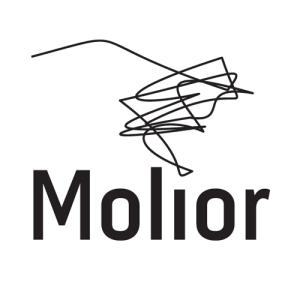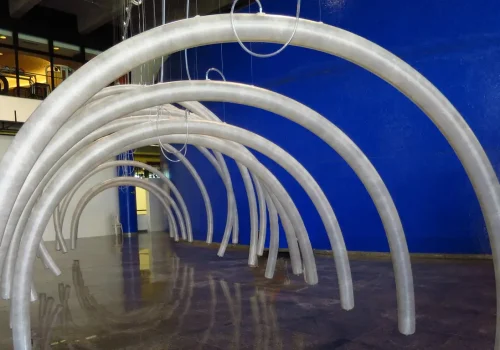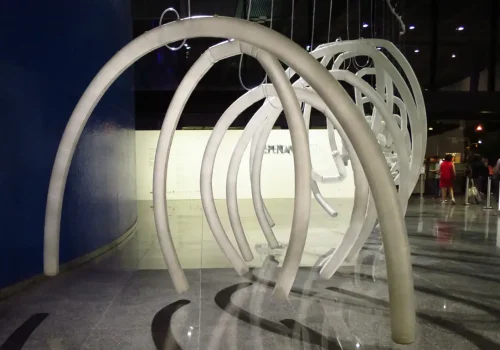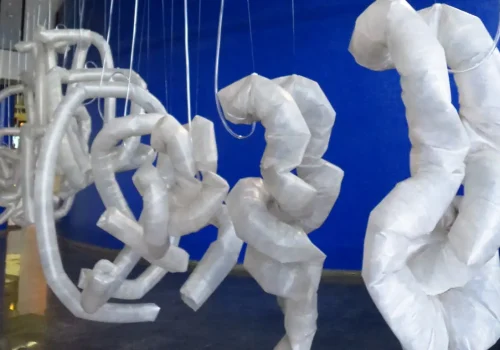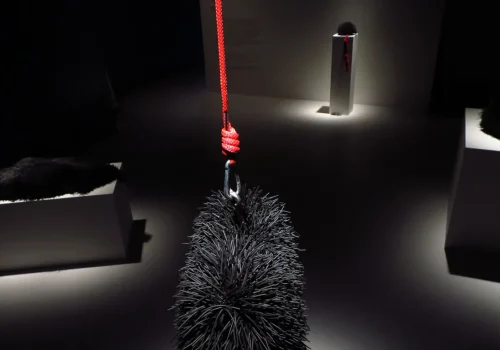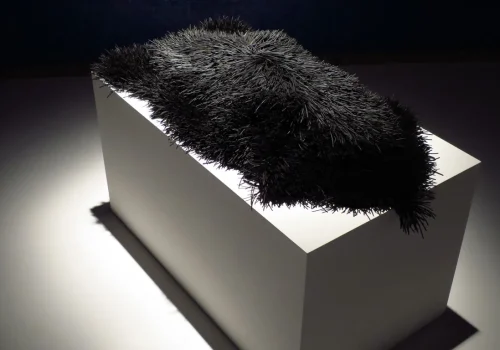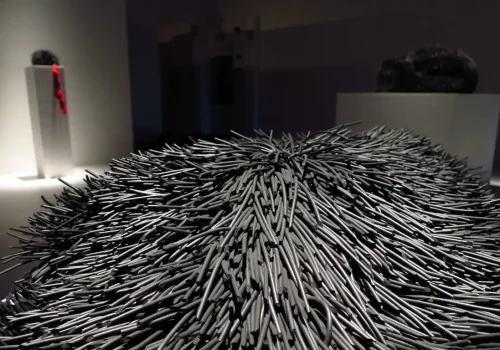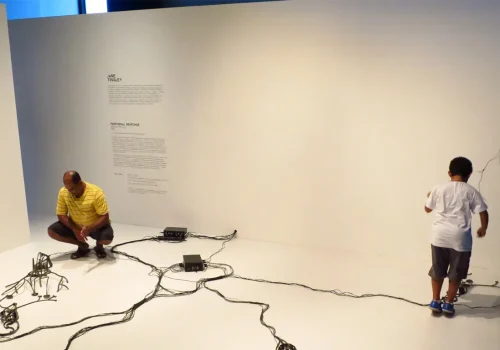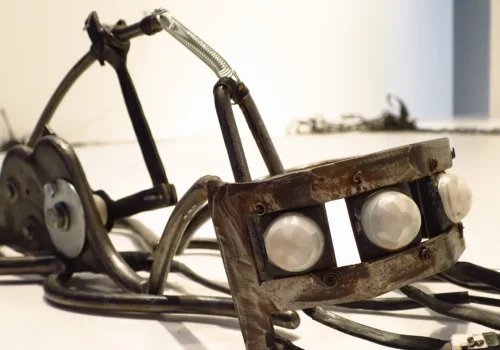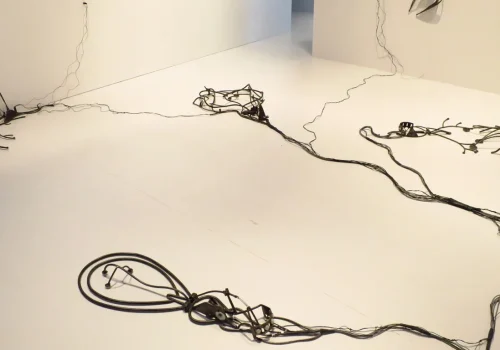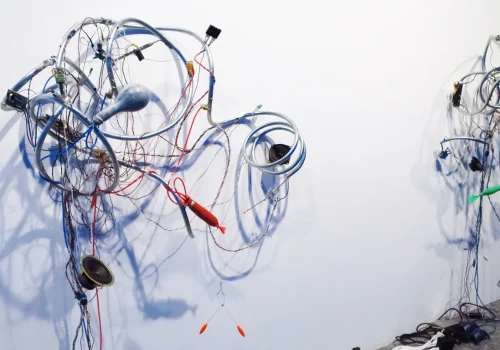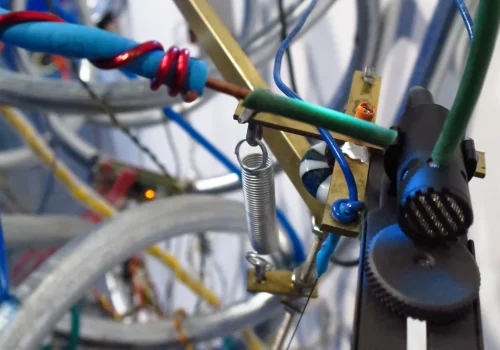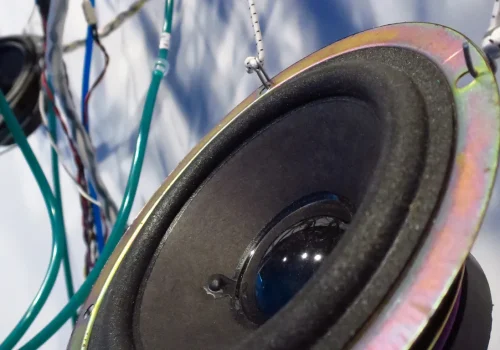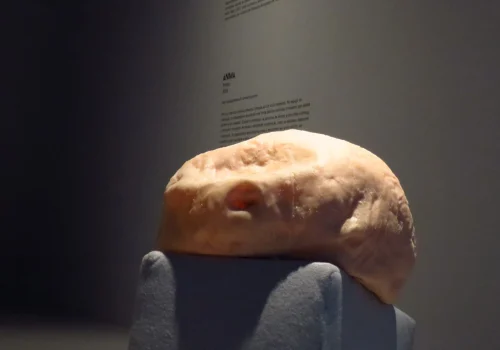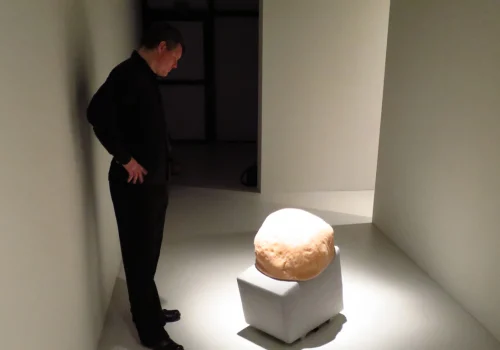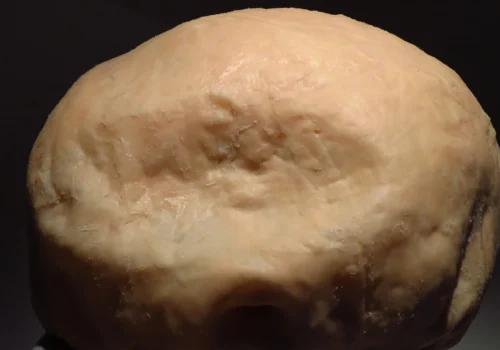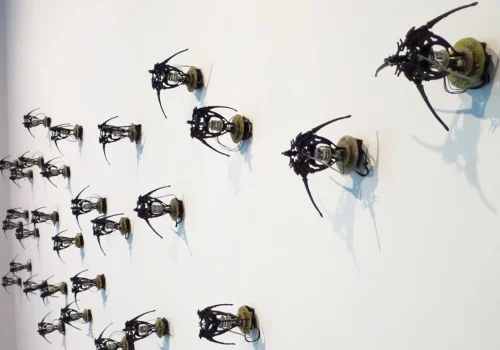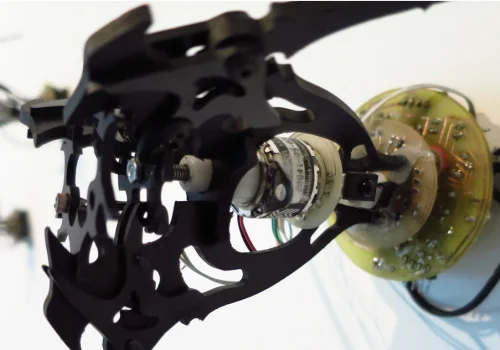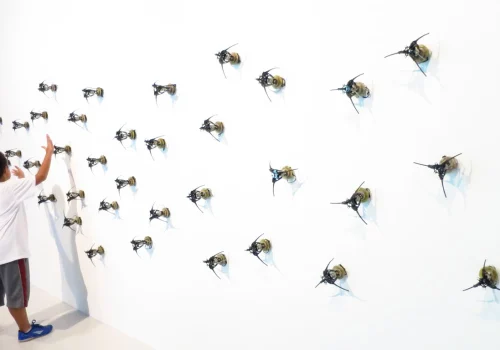ÉVEIL/ALIVE at SESC Santana
São Paulo, Brazil
From March 13th to June 1st, 2014
All beings circulate through each other (Diderot, D’Alembert’s Dream)
The exhibition Éveil/Alive is inspired by a distant and primordial moment: the origin of life, the coming alive of matter. It appears that the scientific community can not fully agree on a current theory regarding this extraordinary moment. Abiogenesis, the study of how life arose from non-living matter, has considered several hypotheses among which the primordial soup is the most well known. For their part, researchers in the field of synthetic biology are attempting to produce life forms artificially, but the results have been inconclusive up to now. To this day the passage from the inorganic to the living remains enigmatic and this mystery continues to arouse our curiosity. It has been the driving force behind many efforts to explain, reproduce and imagine this leap.
As far as they are concerned, artists of course do not claim to solve this enigma. It is nevertheless something many among them reflect about. To bring life to objects or formless materials, which only become remarkable once an artist begins to reshape them, is a means to approach, by analogy, this turning point where the inert becomes animated. The process of creation awakens what was dormant and awaiting a future, and activates its potential to become something else, stirring with vitality and reflecting life in those who contemplate it. It summons this spark of life which emerged a long time ago to disrupt and awaken matter from its quiet slumber.
More specifically, some creators use movement to give their works a life-like appearance in a more eloquent manner. The legend of the Golem, Daedalus’ statues, the Frankenstein movies (“it’s alive !”), the anthropomorphic puppets and automatons from the past to today, are the products of the imagination in which the living is understood through movement, endowing these sleeping creatures with life. The human figure is the reference par excellence in these productions, which is consistent with mankind’s deep seated view that life’s ultimate accomplishment is best expressed by anthropomorphic representation. With this exhibition we have chosen a standpoint that is far removed from this tendency. In fact, the works chosen for Éveil/Alive present living forms in their nascent, imprecise states and thus take leave of the human figure to return to the beginnings of the organic world.
The exhibition brings together kinetic and robotic works which use movement to express the essence of the living. By way of various technologies, these works cause their components move, shake, wriggle and unfold in a way that evokes biological processes and primitive living beings. They are of the order of the pre, the sub or maybe the intra-human. Not a single work among them even represents an animal species or a recognizable organ or organism. Thanks to this semantic imprecision and the rudimentary forms, they confront us with the living in its secret and intimate dimension.
Life begins with small matters. Though Chico MacMurtrie’s big organic arches unfold in a process that reconfigures the surrounding space and incorporates us, they also have a formal affinity with inner bodily architecture, recalling cellular, muscular or skeletal spaces. For their part, the delicate creatures which make up Steve Daniels’ installations are more likely to evoke small organisms or insects, for instance. They attract attention, stimulate observation and elicit surprise.
In walking through the exhibition, one is never quite certain with what sort of single-cell being, animal species or internal organ one is dealing with. One remains on the level of the minute—either because of the objective dimensions of the components or the scale they allude to—all the while being progressively immersed in a full and animated space. Jane Tingely’s slender creatures, clinging on the floor or the walls, create a living milieu, an ecology in which each of the beings is linked to the others. It is hard to determine whether Ingrid Bachmann’s sculptures, of various forms and dimensions, are the figure of one organism in various stages of development or assuming various postures, or rather of several, yet similar creatures. They make up their own organic world taking on different shapes according to time or space, and which invite one to reflect about the kinship that links living things.
It is through micro-movements in the entrails of his sculptures—expressed via sound in the surrounding space by way of small microphones and speakers—that Jean-Pierre Gauthier’s sculptures come to life. The sound ambiance, in which the viewer and listener is immersed, recalls an unstable and constantly transforming natural milieu. For its part, Anima by Paula Gaetano Adi, with its unique shape in the middle of the room where it is displayed, embraces its surrounding space and forcefully draws visitors in through the attraction and fascination it exerts upon them. This membrane, which expands and contracts to the rhythm of its breathing, in and of itself represents a living organism in its simplest expression; elementary in both shape and movement, its has an expansion capacity that goes beyond its physical limits.
Among the biomimetic movements these works make use of, the vital action of breathing is present in the works of Gauthier, Gaetano Adi, Bachmann and MacMurtrie by way of pneumatic or motorized mechanisms. The eminently fundamental respiration movement affirms aliveness in a repetitive and insistent manner. The skins which rise and descend, the pouches which inflate and deflate, the tubes which stretch and collapse, the cavities which are filled and emptied according to a slow and sustained rhythm, each take up this means which Nature has chosen to keep itself alive.
Equally subtle and restrained biomechanical movements characterize other projects. Simple gestures of a limited range, take inspiration in biological systems and living processes. The rising and opening actions (Daniels, Tingley) and those of sliding, pushing and vibrating (Bachmann, Gauthier), for example, demonstrate a will to participate in an environment, to connect with one’s surroundings and exchange with one’s fellow creatures. These social behaviours, in combination with multiplication and propagations, symbolize growth and regeneration, which are fundamental natural phenomena aimed at maintaining life and ensuring survival.
The works of the exhibition are also characterized by their sensibility. Equipped with sensors and feedback devices, they perceive and respond to their environment, sometimes is an instantaneous and decipherable way, and at others according to a choreography that escapes us. Many are interactive, others function according to their internal logic and several seem to ignore us, preferring to rest instead. The unpredictable character and diversity of these actions and reactions approach the behavioral complexity of living organisms.
Each of these works lays bare all that is it is: interiors are exposed, components are fully visible, and the inside is turned outwards. The surfaces (Gaetano Adi, Bachmann, MacMurtrie) are actually interfaces, because what they cover is not hidden. First of all, there is the very real air, even if invisible and intangible, which circulates through the membranes from the outside to the inside, and vice versa. Then there are the mechanisms, which when they are not visible, remain secondary, for in this case the technology is not an end in and of itself. In the other cases, it is hard to distinguish if the envelopes which we are shown represent the external surface of organs or internal organisms. What’s certain, is that we are undoubtedly on the inside (of the outside, or on the outside of the inside). Also what is one to make of the fine metallic structures (endoskeleton or exoskeleton?) and the visible wires in the works by Daniels, Gauthier and Tingley? Stripped of their skins, these creatures appear to exhibit their entrails. Through various means, these projects give one the impression of being at the heart of the living and invite us to make a connection with our own vital functions.
This laying bare also involves the materials and technologies. The industrially made components never hide their manufactured origin. These projects do not try to outdo the natural world and they never claim to be in competition with living beings. Their obvious artificiality creates a distance that places them clearly within the field of fiction, a fiction whose plot unfolds at the threshold of life.
The works propose a very physical, immediate and enveloping relation, a relation that is renewed from one project to the next. There is not a single image in these installations that immediately leads one into a representational realm. It as though we were fully a part of these environments in which thought is suspended in its grasp over things. This vagueness and multi-referential character of the works also prevents representation from intervening in one’s perception of the projects and fixing one’s mind. This primarily physical and sensory aspect allows the viewer to identify with the works and to experience an organic continuity.
All living beings have a shared organic origin. But we can go even further and conceive that we are also this matter that one day decided to come alive. The living is also in the non-living, from the beginning of history to present time, through the objects we make and works of art we create in the sedimented remains of those who—regardless of their species—preceded us, in the air that we breathe.
[Sylvie Parent, curator]
Sylvie Parent
Sylvie Parent is an independent curator and art critic. She has been involved in the visual and digital arts scene for more than 30 years, both in Quebec and abroad. Her exhibitions have been shown in Canada, the United States, Italy, Brazil, China and Taiwan.
From 2009 to 2014, she was artistic director of Molior, an organization specialized in the production of exhibitions on the international scene. In the field of publishing, Sylvie Parent acted as editor of magazines such as HorizonZero (2003-2005) and CIAC Electronic Magazine (1997-2000), and contributed to several specialized journals (Parachute, Ciel variable, Espace art actuel, etc.).
She is also the author of numerous essays for exhibition catalogues. Sylvie Parent is a recipient of the Joan-Lowndes Award (2017) given by the Canada Council for the Arts to an independent art critic or curator in recognition of the outstanding quality of her work.
Chico MacMurtrie / Amorphic Robot Works
Organic Arches
2014
Inflatable robotic installation
High tensile Tedlar fabric, software (MaxMSP, Abelton Live), hardware (valves, electronics, custom machined fittings, connectors)
Description of the work
Created specifically for the exhibition, Organic Arches is a major project set up in the SESC Santana hall. It is a kinetic architectural environment that continuously recomposes the space in which it is displayed. Conceived with pneumatic technologies, the project uses flexible and resistant materials which adapt to the installation’s changing forms. Put into motion through progressive inflation and deflation, the structure expands until it attains its maximal state in which it takes on the shape of a series of floating arches. At its different stages of expansion or contraction, the installation displays a configuration of constantly changing organic forms.
Visitors can decide to view the work from its inside or its outside in order to view its slow metamorphoses. The project creates correspondences between open architectural structures (arches, caves, tunnels) and organic ones (skeletons, muscles), which are interlinked as the forms progressively emerge or disappear. Organic Arches is based on the affinities between the built and organic environment, and it encourages us to refer one to the other and to trace the formal continuities between the architectural constructions and the biological world. The project takes inspiration in living processes, such as breathing and growth by emphasizing their unstable and cyclical nature.
Team of Amorphic Robot Works : Chico MacMurtrie (Artistic Director), Luise Kaunert (Artist Representative, Project Manager), Bill Bowen (Software, Hardware), Mathew Galindo (Inflatables technician), Zyia Zhang Zhongyuan (Inflatables technician)
Biography
Chico MacMurtrie is internationally recognized for his large-scale, performative, kinetic installations, and interactive public sculpture.
He graduated from UCLA (New Forms and Concepts) in 1987, and has exhibited widely in America, Europe, and Asia.
He has received fellowships and awards from the Rockefeller Foundation, the Daniel Langlois Foundation, the National Endowment for the Arts, the Fundación Telefonica / Vida Life, CEC Artslink and Ars Electronica.
MacMurtrie is the Artistic Director of Amorphic Robot Works (ARW), a collective he founded in 1991, comprised of artists, scientists and engineers.
MacMurtrie’s / ARW’s new media installations have been exhibited in numerous museums including: Reina Sofia Museum, Madrid (2008), National Art Museum of China, Beijing (2008), Wood Street Gallery, Pittsburgh (solo show; 2009), Museo Universitario de Arte Contemporáneo (MUAC), Mexico City (2009), The National Gallery of Macedonia, Skopje (solo show; 2010), ZER01 Biennial, San Jose (2010), Beall Center for Art and Technology, Irvine, CA (solo show; 2011), Richard L. Nelson Gallery / UC Davis, CA (2011), 9th Shanghai Biennale, Power Station of Art, (2012), MOCA, Tucson, AZ (2013).
Ingrid Bachmann
Pelt (Bestiary)
2012
Kinetic and Interactive Installation
Description of the work
Ingrid Bachmann’s installation is comprised of several sculptures made out of the same material: black rubber neoprene sheets covered with long flexible bristles. It recalls spine-covered animal coats, abundant furs, ciliated membranes of marine animals or single-cell organisms. Using a synthetic material the artist fashions creatures which reference animals in multiple ways.
These sculptures, made up of variable forms and dimensions, take on behaviours that also distinguish them from one another. Thanks to small mechanisms hidden within their covering membrane, these sculptures move in a manner that resembles living beings. Their movements, ranging from the slow and hesitant to the nervous and excited, express an inner reality (a vital function or an emotion) or a skin reaction (excitement, defense or protection) to their environment. The hairiness further underscores the skin’s sensitive nature and its role as an interface between inside and outside.
Displayed on pedestals, suspended or wall-mounted, these creatures make up a collection of pseudo-living organisms which resemble laboratory specimens exhibited in natural history museums, in a taxidermists’ workshop or as hunting trophies, and thus bear witness to our fascination with living beings.
Team: Sarah Comfort, Dana Dal Bo, Chris Flower, Martin Peach, Jonathan Villeneuve, AF Wauthy
Thanks to: Canada Council for the Arts, FQRSC
Biography
Lives and works in Montreal
Ingrid Bachmann is known for her interactive installations that combine technology and everyday objects. Her multidisciplinary works draw on the textile, sculpture and kinetic art fields. Her use of technology seeks to demystify it and make it more human, by integrating a sensual and emotional dimension that counters the alienation that is often associated with the machine.
Her work has been exhibited in Quebec, Canada and abroad, notably in Europe on several occasions. She has also taken part in many international visual and digital arts events. Molior presented her work as part of Despertar / Éveil / Alive at Sesc Santana in Sao Paulo (Brazil) in 2014, Transitions / Transiciones, at Centro Cultural de la Pontificia Universidad Católica del Perú, Lima (Peru) and during B/R/T Le corps habité in Montreal, 2007.
An associate professor at Concordia University (Montreal), Ingrid Bachmann was a founding member of Hexagram, an interuniversity media arts research and creation centre. She is the director of the Institute of Everyday Life, a studio laboratory that examines everydayness. She has been a guest speaker at Goldsmiths College (London, UK), the University of Wollongong (Australia), the University of Maryland (Baltimore) and the Art Institute de Chicago.
Jane Tingley
Peripheral Response
2006
Robotic Installation
Description of the work
Peripheral Response presents a set of metallic sculptures displayed on the floor and the walls. The works are linked through electrical and computer networks. Distinct in their forms and dimensions, they evoke both tree branches and roots as well as crawling or climbing animal species. These small creatures with thin arms, respond to visitors’ movements by emitting clicks that recall the sound of footsteps, brief screams or repetitive calls of small animals reacting to their environment. These hybrid beings, which consist of visible structures, are reduced to their skeletal state and to the drawings they produce in the space to better reveal their systems and their fundamental links.
The reference to the nervous system is also made explicit in the intertwining of wires and networks, as though the installation made it possible to visualize the impulses and interconnected exchanges that occur in a living organism. The sculptures become the nerve endings or intersections, each being defined by its function and location. Whether it be in a natural milieu where many plant and animal species live side by side or in the depths of the nervous system, the installation takes viewers on a journey through a pared- down and intimate world in which the components’ interdependence is brought to the fore.
Team: Special thanks to Martin Peach
Thanks to: Manitoba arts Council, PEO, CIAM
Biography
Jane Tingley, who received her MFA from Concordia University in 2006, uses new media, sculpture, and installation to explore ideas involving identity and contemporary experience.
She is one of the founding members of the Modern Nomads and has participated in exhibitions and festivals in Canada, Asia, and Europe, including Translife – International Triennial of Media Art at the National Art museum of China in Beijing, the Canadian Embassy and Gallerie Le Deco in Tokyo, Japan, Festival Break 2.3 in Ljubljana, Slovenia, Elektra Festival in Montreal, and the Künstlerhaus in Vienna, Austria.
She was awarded the Kenneth Finkelstein Prize in sculpture, and has received support from a number of funding agencies, including the Manitoba Arts Council, Conseil des arts et des lettres du Québec, and the Canada Council for the Arts.
Jean-Pierre Gauthier
Hypoxia (# 3 and #4 )
2011
Sound and kinetic installation
Description of the work
The two sculptures by Jean Pierre Gauthier presented in the exhibition are kinetic works which use air to create sound effects. Resembling a French horn that has been taken apart in a bizarre way, each of these sculptures consist of a curved metal tube with grafted-on silicone tanks as well as electronic circuits, and electrical and pneumatic networks which control sound devices. The air variations around the small microphones triggered by the internal movements create surprising natural phenomena sounds (moving wind, a breaking wave, etc.) or animal sounds (bird chirps, cries of small mammals). Before these sculptures the viewer has the impression of being in a natural environment.
The components are replete with references to the organic world: the tube coiling up and unfurling as it draws a figure which evokes a ribcage or a skeleton; the threads resembling nerve fibers or blood vessels; the inflated and deflated pouches recalling lungs or vital organs; the small moving and vibrating speakers which are extensions reminiscent of sensory extremities such as the mouth or ears.
Though these sculptures resemble living organisms, they do not hide the fact that they are manufactured and made up of industrial and technical materials. They are wind instruments that give shape to life through sound.
Team: David Jacques (Metal tubing), Pascal Audet (Programming)
Thanks to: Canada Council for the Arts
Biography
From the start Jean Dubois has focused his research on the interactions of the body and technological devices, notably the touch screen and mobile telephony, as well as on the intersubjective relationships that underpin them. His work also draws on a combinatory textuality structured around mots-valises, concrete poetry or polyphonic conversations.
His works have been shown in several art centres, museums, biennials and festival in Canada and abroad, notably at the Biennale internationale d’art numérique (Montreal), CyberFest at Hermitage Museum (Saint Petersburg), Biennale de Montréal, Incheon International Digital Art Festival (South Korea) and at the International Biennial of Media Art (Melbourne). Molior presented his interactive video panel Tact (2000-2001) in 2006 during the exhibition À l’intérieur/Inside put together by Sylvie Parent for the Third Beijing International New Media Arts Exhibition and Symposium at the Millennium Museum, and in 2009 as part of eARTS BEYOND: Shanghai International Gallery Exhibition of Media Art, under the artistic direction of Zhang Ga.
He teaches at École des arts visuels et médiatiques de l’Université du Québec à Montréal where, until just recently, he was the vice-dean of research and creation. He is also among the founding members of Hexagram, an interuniversity media arts research and creation centre and he was the chair of the board of directors of Vox, Centre de l’image contemporaine.
Paula Gaetano Adi
Anima
2009
Autonomous Robotic Agent
Description of the work
Anima is an interactive robotic work comprised of a single element. In the installation space viewers encounter a reclined and supple spherical form which seems to be sagging on a pedestal. In approaching Anima, the work inflates and then begins to contract and expand in a breath-like manner, as though it were breathing in and out. Viewers approach it and discover its only orifice, a small hole that opens and closes to the rhythm of its “breathing.” Anima is above all a robot that breathes, a breathing machine which expresses its intimate state through the quality of this breathing: deep or shallow, jerky or fluid, intermittent or continuous. Anima is based on the idea that life is linked to breath and proposes that it can be expressed by the qualities of this breath.
The flesh-coloured work can evoke an internal organ such as a lung, a marine animal or a single-cell organism, though one can not discern what it really is. It is something familiar, something visceral as well as a primitive life form. It certainly engages us in a direct encounter, a dialogue, a communication that involves a body language which makes us reflect on our own state as living organisms.
Biography
Born in Argentina, Paula Gaetano Adi is an artist and researcher working in sculpture, performance, interactive installation and robotics.
Using the human and nonhuman body as a point of departure, her work deals with different cultural studies of technoscience particularly in regard to how its discursive effects and affects are inscribed in human subjectivity and how these can be reflected through art.
Her work has been presented internationally in exhibitions in Beijing, Berlin, Madrid, Moscow, Stockholm, São Paulo, New York, Poznan, Buenos Aires, among others. She was the recipient of numerous grants and honours, including the First Prize of VIDA 9.0—the international competition on Art & Artificial life, the First Prize of LIMBØ—Museum of Modern Art of Buenos Aires, the National Endowment for the Arts, the Fergus Memorial Scholarship in 2009 and 2010, and the 2012 Artistic production Incentive Grant for Ibero-American Artists awarded by VIDA 14.0.
Currently, Gaetano Adi is Assistant Professor of Studio Art at the University of North Texas, College of Visual Arts and Design, where she coordinates the New Media Area. Also at UNT, she has recently joined the Initiative for Advanced Research in Technology and the Arts (iARTA).
Steve Daniels
Sessile
2008-2011
Motors, custom electronics, CNC cut PVC, ABS and Nylon
Description of the work
Sessile displays several identical elements placed on a wall. Sensitive to light, these elements are equipped with limbs that rise in reaction to the shadow cast by the visitor and thus function somewhat like a defense mechanism. These little creatures also communicate between each other and can detect, influence or be influenced by the behaviour of their fellow creatures. In the process they create feedback loops which sometimes give rise to surprising events. Viewers witness a synchronized movement or a reverberation effect, as if the movement passed from one element to the other. At other times, their gestures seem chaotic and hard to understand. It is precisely because of this unpredictable behaviour that they so closely resemble living organisms which are constantly interacting with and adapting to their environment.
Due to their delicate appearance and movements these creatures look like insects. Their social behaviour also seems to be inspired by organisms that live in colonies, such as bees or ants, since each one of them is fundamentally linked to the others in what can be called a superorganism. Viewed individually these creatures are of limited interest, it is rather as collaborative and information-sharing entities that they prove to be significant. Using distributed intelligence methods from which a feedback system emerges, this artificial colony functions according to its own ecology by imitating complex processes of the biological world.
Biography
Steve Daniels uses electronics and communication technologies to create hardware agents, kinetic sculptures, ubiquitous spaces and networked events. He is currently interested in the non-utilitarian possibilities of DIY social devices.
Through his practice Steve juxtaposes disparate knowledge systems and experiences in an effort to reveal their underlying structures and assumptions.
Steve has presented his work in galleries and festivals including at the Ontario Science Centre (Toronto), Future Sonic (UK), DorkBot (Toronto), Bay Area Maker Faire (USA), thelivingeffect (Ottawa Art Gallery), Elektra (Montreal), Subtle Technologies (Toronto), and Common Pulse (Toronto). His work was recently included in the MACHines show at the Centre des Arts, Enghien-les-Bains (France).
Steve is currently assistant professor and Director of the New Media program in the RTA School of Media Ryerson University. Steve teaches courses in Malleable Media, Physical Computing, Telepresence and Networked Objects. He holds an MSc from the University of Manitoba (Zoology, Behavioural Ecology) and is a graduate of the Integrated Media program at OCAD in Toronto.
